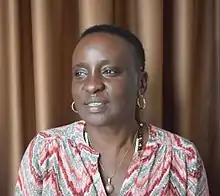
Lilian Mary Nabulime (born 22 December 1963) is a Ugandan born sculptor and senior lecturer of Fine Art. She is a lecturer at the College of Engineering, Design, Art and Technology (CEDAT) and has published and exhibited her works in various exhibitions both national and international.[1]
Biography
Nabulime was born in Kampala district, central region of Uganda, in 1963 and studied at Nkoni Girls' Primary school where she obtained her PLE certificate, she then went to Makerere College School for both her O levels and A levels. She obtained her bachelor's degree in fine art at Makerere University in 1987. She obtained her master's degree at Makerere University and her PhD at Newcastle University in 2007. This research was on The role of sculptural forms as a communication tool in relation to the lives and experiences of women with HIV/AIDS in Uganda.[2]
Career
Nabulime is the Senior Lecturer and former Head of the Sculpture Department in the School of Industrial and Fine Arts, College of Engineering, Design, Art and Technology (CEDAT), Makerere University. Her work uses ordinary objects (for example, soap, sieves, cloth, mirrors, metal cans, car parts and found objects) to embody a specific social agenda, such as disease, gender, and environmental issues that attempt to raise awareness and promote discussion as well as moving the meaning of art beyond the visual.[3][4]
Awards and fellowships
References
- ↑ "Lillian Mary Nabulime".
- ↑ "The role of sculptural forms as a communication tool in relation to the lives and experiences of women with HIV/AIDS in Uganda".
- ↑ "Lillian Nabulime addresses girl child in exhibition".
- ↑ "Nabulime's bold and beautiful art lights up the work place".
- ↑ "Using Art to talk about HIV/AIDS".
- ↑ "Using art and everyday objects to fight HIV/AIDS in Uganda" (PDF).